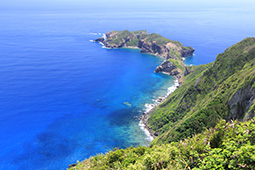INDEX
- English
- 日本語

Omura Beach, Chichijima Island - English
- 日本語

A sunset viewed from the Weather Station observation deck on Chichijima Island

Hiking on Mt. Asahiyama, Chichijima Island 
Scenic View from Mt. Chibusa on Hahajima Island
November 2021
The Ogasawara Islands: “Galapagos of the Orient”

The Ogasawara Islands, located in the Pacific Ocean approximately 1,000 kilometers from central Tokyo, have been dubbed the “Galapagos of the Orient” due to the presence of many flora and fauna species that have evolved there independently.

The Ogasawara archipelago comprises some thirty islands located roughly 1,000 kilometers from central Tokyo. As there is no airfield, the only means of access to the islands is by ferry, which takes around 24 hours from the Port of Tokyo. Although administratively Ogasawara is a part of the Tokyo Metropolis, only two of the islands are inhabited, Chichijima Island and Hahajima Island. The rest are all unpopulated.*
The Ogasawara Islands were formed not by breaking off from the mainland but owing to seabed uplift caused by volcanic activity. The flora and fauna that inhabit the islands have evolved independently over a long period of time after having come ashore on the wind and driftwood and adapted to the environment of the islands, resulting in the Ogasawara Islands being dubbed the “Galapagos of the Orient.” In recognition of their unique and rich ecosystems, the Ogasawara Islands were inscribed on the World Natural Heritage list in 2011.
The total area of the islands in the archipelago is just 105 square kilometers in a subtropical climate zone. The sea area is home to marine animals like dolphins, whales, and sea turtles. The land area is home to many endemic species, including flora such as the camellia himetsubaki** and the peony muninnobotan***, birds such as the Bonin white-eye****, insects such as the weevil himekatazomushi*****, and land snails such as the katamaimai******. Land snails, in particular, expanded their habitat to various locations on the islands and adapted to the environment of each location. As a result, some extraordinary speciation******* occurred, with the evolutionary process continuing even today.

“The islands of Ogasawara are home to more than a hundred species of land snails. As if that were not impressive enough, more than 90 percent are endemic to Ogasawara,” says Wakamatsu Yoshiki of the Ogasawara Nature Conservation Office of the Ministry of the Environment, as he explains why the islands are special.
According to Wakamatsu, the extinction rate of land shellfish species on the Ogasawaras is lower than that of other oceanic islands, most likely because they were not settled until around 1830 and there has been little environmental change caused by development. As a result, “By researching extant species, researchers can follow species’ evolutionary line and transitions from the past to the present,” says Wakamatsu.

One of the places to enjoy the abundant nature of Ogasawara is Omura Beach (also known as Maehama), which is located near the port that connects Chichijima Island to the mainland. Even without diving in, visitors can see the coral and fish swimming in the crystal clear water there. The Weather Station observation deck overlooking the sea on the west side of Chichijima Island is also popular as a place from which to watch the magnificent sunset over the Pacific Ocean. On a clear day, the view extends all the way to Hahajima Island. When it comes to observing the flora and fauna on Chichijima Island, a hike up Mt. Asahiyama is recommended, with a well-maintained trail to the summit (267 meters above sea level) making the hike accessible even to children. Before the impact of COVID-19, tourists from overseas were a common sight. There are many special locations, such as Samegasaki Cape on Hahajima Island, where whale watching can be enjoyed even from the land at certain times of the year, and Mt. Chibusa (463 meters above sea level) where a treasure trove of native vegetation can be enjoyed.
The stunning natural environment of the Ogasawara Islands has also earned them the nickname “Japan’s paradise.” The flora and fauna unique to the Ogasawara Islands are a part of their charm.
* There are some officers in a facility of the Japan Self-Defense Forces in Iwo-to Island, and facilities of the Japan Self-Defense Forces and the Meteorological Agency in Minamitorishima Island.
** (Schima wallichii)
*** (Melastoma tetramerum)
**** (Apalopteron familiare hahasima)
***** (Ogasawarazo rugosicephalus rugosicephalus)
****** (Mandarina mandarina)
******* The formation of new and distinct species in the course of evolution

